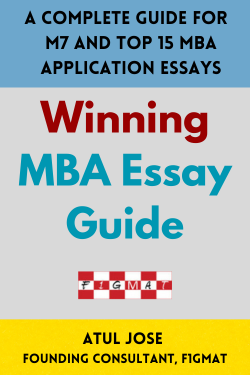 Before embracing the MBA admission season, you must mentally prepare to juggle priorities and endure GMAT Preparation, School selection, coordinating recommendation letters with supervisors, and maintaining performance at work while also being in a healthy relationship with your partner.
Before embracing the MBA admission season, you must mentally prepare to juggle priorities and endure GMAT Preparation, School selection, coordinating recommendation letters with supervisors, and maintaining performance at work while also being in a healthy relationship with your partner.
We have prepared 5 Ideas for tweaking your behavior in conventional and some unconventional ways.
Do remember, there is no one-fit rule for all. Test the ideas.
1) Planning for the Hour
A common tweak in your behavior – “planning for the hour” involves setting aside 30 minutes at the end of every day and planning for the next day on an hourly basis. The template looks like this:
-------------------------------------------------------------------------------------------------------
5:30 – 6:00 (Morning Routine)
6:00 – 6:30 (Gym)
7:00 to 7:45 (GMAT Probability – 10 Questions OG)
13:30 to 14:00 (GMAT Distance & Speed – 5 Questions)
Review GMAT Quant Notes
19:00 to 20:00 (GMAT Critical Reasoning – 5 Inference Questions)
----------------------------------------------------------------------------------------------------
Pros: There will not be a moment in your schedule where you are unsure what to do. This behavior sets up a routine for your 2-3 month GMAT Prep and essays.
Cons: Initially, you might feel that the routine is restricting your behavior and limiting your creativity.
2) Multithreading - 30 Minute Bursts
For those applicants who feel that the hourly routine restricts them, the 30-minute burst is an effective strategy to focus on one task at a time. If you are familiar with the concept of multithreading, Computer processors create the illusion that they are handling multiple tasks simultaneously. In reality, they are switching between tasks at an alarmingly fast speed. Human minds cannot function at that efficiency, but the idea of multitasking has been proven ineffective. Multithreading is effective. A 30-minute burst is followed by a 10-minute break, followed by a 20-minute burst of another task.
The schedule looks something like this:
-------------------------------------------------------------------------------------------------------
14:00 – 14:30 : Team Meeting
14:30 – 14:40: Break
14:40 – 15:10: GMAT Concepts (4 questions + Fundamentals)
-------------------------------------------------------------------------------------------------------
Pros: You don’t feel bogged down by the routine. The switch helps you experience multiple problem-solving capabilities.
Cons: Some applicants get into the mojo once they warm up with a 30-minute GMAT preparation session. After that, they are ready for more. When you switch at this time, the adjustment to a different task kills the mojo. In effect, both tasks are completed at sub-standard efficiency.
Even in multithreading, you must plan for 30 minutes - the day before the schedule.
3) Planning for Mood
Applicants who get into the ‘mood’ can work continuously for 2-3 hours without any distraction. For them, planning for the hour or 30-minute burst might not be effective. There is a total fixed hour set every day.
The schedule looks like this:
-------------------------------------------------------------------------------------------------------
23rd June - GMAT Verbal (3 hours 15 Questions )
24th June – GMAT Quant (2 hours 15 Questions)
-------------------------------------------------------------------------------------------------------
Pros: The pressure to follow the routine is taken away, and the applicant can focus on the topic.
Cons: Applicants might not be in the ‘mood’ every day and skip the required daily targets. When the missed hours add up, the stress to compensate for the lost hours can distract the applicant.
4) Planning for Energy
This strategy has been found to be the most effective. Don’t plan for the hours but plan for your energy level. During mornings if you are most effective at your work, don’t include 10-minute or 20-minute GMAT prep time. If noon is the least energetic, schedule passive events like group meetings. If you are at the peak after work or just after a workout in the morning, schedule GMAT prep sessions for that time.
Most applicants have shared that they have the most energy and least distraction for writing MBA Application essays late at night and morning right after a Gym workout, they are at their peak GMAT problem-solving mode. If that is the case, split 1 hour into the early morning and late-night sessions.
The schedule looks like this:
-------------------------------------------------------------------------------------------------------
6:00: 6:30 – Gym
7:00: 7:30 – GMAT Problem Solving
23:00 - 24:00 – HBS MBA Essay (Draft 1 – Essay 1)
-------------------------------------------------------------------------------------------------------
Pros: You are more likely to be at your efficient best when tasks are allocated according to your energy level.
Cons: The energy level varies if you have a stressful day at work. The evening session might get impacted.
5) Intense Preparation
Intense preparation works for those who can easily manage distractions. This is not recommended for applicants who get carried away by social activities or other distractions. This plan follows a schedule where instead of 1-2 daily hours on GMAT prep, School Selection, and MBA Application Essays, you dedicate 4-5 hours on your MBA application, including GMAT, every day and take routine breaks every 3rd day.
The schedule looks like this:
-------------------------------------------------------------------------------------------------------
Monday 17th July
GMAT Permutation and Combination (3 hours)
HBS Essay (100 words or opening paragraph) - 2 hours (Draft1)
Tuesday 18th July
GMAT Exponents & Number Properties– 3 hours
HBS Essay (200 words) – 2 hours (Draft 1)
Wednesday 19th July - Party/Movie/Favorite TV Program (Binge-watching)
Thursday 20th July
GMAT Parallel Construction (1 hour)
GMAT Paraphrasing Argument (1 hour)
GMAT RC (1 hour)
HBS Essay (400 words) – 2 hours (Draft 1)
Friday 21st July
GMAT Interest Problems (2 hours)
GMAT Venn Diagram Questions (1 hour)
HBS Essay (400 words) – 2 hours (Draft 1 Complete)
-------------------------------------------------------------------------------------------------------
Pros: You complete topics at a faster pace
Cons: If you are easily distracted, coming back to the 2-day intense MBA Application schedule will not be easy.
Daily Review
Whatever be your time management strategy for MBA Application, review your progress every day, and note down your weaknesses. If you miss the schedule one day, make sure you compensate the next day. If you keep a backlog for more than 2 days, it will add up and discourage you from staying on course with your MBA Application.
If you have not shortlisted your school, subscribe to our comprehensive Career Planning Service.
If you have selected the school but need help with shortlisting stories, editing, and reviewing your essays, choose F1GMAT’s Essay Review Service.
 I will teach you how to bring your life stories to essays faster with F1GMAT's essay guides. Download below or subscribe to F1GMAT's Service and work with me - Atul Jose, Author/Editor/Founding Consultant, F1GMAT(16 Years of helping applicants gain admissions to M7 and Top 30 schools)
I will teach you how to bring your life stories to essays faster with F1GMAT's essay guides. Download below or subscribe to F1GMAT's Service and work with me - Atul Jose, Author/Editor/Founding Consultant, F1GMAT(16 Years of helping applicants gain admissions to M7 and Top 30 schools) 